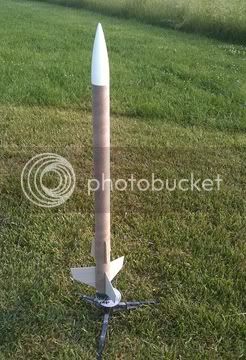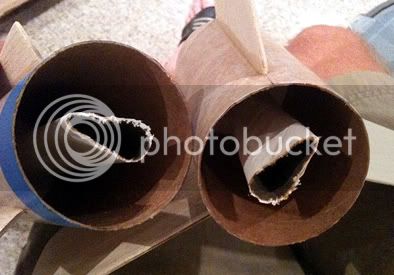A few weeks back, I noticed Hobbylinc had 5-packs of BT-80 on sale for super cheap, so I picked up a couple for use on some projects.
I had always liked the Estes Optima / Shadow, but it's out of production. Thankfully the plans are all online and Excelsior even offers the decals. The build was pretty straight forward with the exception of the super long stuffer tube setup and multiple (5) centering rings. Essentially, there's one big BT-50 stuffer tube that spans all the way up until 12" or so from the top. The fins are so big that they're a two-piece design so they can be cut from 4" wide balsa.
Anyway, I was pleased with the result and had to fly it on a clear day...without paint or decals. It did great on D12's and was impressive on E9's. It somewhat reminded me of the Excecutioner (same lift-off speed and flight characteristics).
Here's a shot of it on the pad waiting...

You really don't realize the scale of this thing until you see it up close. It's pretty beefy for an Estes design. That's a normal Estes pad in the pic for comparison.
Anyway, since I had some time over the 4th weekend and I really wanted to try out my new RMS 24/40 case, I loaded it up with a D15-4 reload and let it rip. The flight went fine (first time ever putting a reload together), but on the landing, the Optima came down onto the gravel / asphault road...nozzle first.
Since the nozzle extends a bit more than the fins, the shock of the landing traveled up the motor casing, to the motor mount and ended up tweaking the stuffer tube right after the thrust block / one of the rear centering rings.
At first I thought it was the ejection charge that had blown out the tube, but then I saw that it was actually the force of the landing...the stuffer looks pinched in on either side about 1/4 of an inch. When you look down the stuffer, you see a rectangular hole since the sides are pushed in. Can't tell whether the stuffer is split. The rear CR is fine and the MMT tube appears to be still straight.
So... what could I do to I try to fix this? I'm worried that the ejection charge from any future launches will blow out the stuffer and end up popping the other centering rings / not ejecting the NC.
I thought about trying to straighten the distorted parts with a dowel through the engine end, but that may not fix it completely. I could try cutting the "fin can" off and trying to splice in a new section of stuffer along with a body tube coupler...
I know that I could just build another, but *sniff*...it's so young, I hate to see this one die without more flights (it needs an RMS E for sure)...or paint for that matter. Any thoughts?
I had always liked the Estes Optima / Shadow, but it's out of production. Thankfully the plans are all online and Excelsior even offers the decals. The build was pretty straight forward with the exception of the super long stuffer tube setup and multiple (5) centering rings. Essentially, there's one big BT-50 stuffer tube that spans all the way up until 12" or so from the top. The fins are so big that they're a two-piece design so they can be cut from 4" wide balsa.
Anyway, I was pleased with the result and had to fly it on a clear day...without paint or decals. It did great on D12's and was impressive on E9's. It somewhat reminded me of the Excecutioner (same lift-off speed and flight characteristics).
Here's a shot of it on the pad waiting...

You really don't realize the scale of this thing until you see it up close. It's pretty beefy for an Estes design. That's a normal Estes pad in the pic for comparison.
Anyway, since I had some time over the 4th weekend and I really wanted to try out my new RMS 24/40 case, I loaded it up with a D15-4 reload and let it rip. The flight went fine (first time ever putting a reload together), but on the landing, the Optima came down onto the gravel / asphault road...nozzle first.
Since the nozzle extends a bit more than the fins, the shock of the landing traveled up the motor casing, to the motor mount and ended up tweaking the stuffer tube right after the thrust block / one of the rear centering rings.
At first I thought it was the ejection charge that had blown out the tube, but then I saw that it was actually the force of the landing...the stuffer looks pinched in on either side about 1/4 of an inch. When you look down the stuffer, you see a rectangular hole since the sides are pushed in. Can't tell whether the stuffer is split. The rear CR is fine and the MMT tube appears to be still straight.
So... what could I do to I try to fix this? I'm worried that the ejection charge from any future launches will blow out the stuffer and end up popping the other centering rings / not ejecting the NC.
I thought about trying to straighten the distorted parts with a dowel through the engine end, but that may not fix it completely. I could try cutting the "fin can" off and trying to splice in a new section of stuffer along with a body tube coupler...
I know that I could just build another, but *sniff*...it's so young, I hate to see this one die without more flights (it needs an RMS E for sure)...or paint for that matter. Any thoughts?




